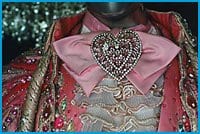It is a source of constant amazement to me that not only did the majority of North Americans never figured out that Liberace was gay, but that they were actually shocked to find out after he died. Sure, you could haul out the tired excuse that it was a more “innocent” time. But however you want to argue it, there is the irreducible fact that there was not a butch bone in that man’s body, and certainly not in his wardrobe. He might have stayed in the closet his entire life, but Mary, this was one gay closet. Judging by Shari Hatt’s show, Liberace’s Closet, at Paul Petro Contemporary Art, this was a closet of Fire Island dimensions.
The show is a result of a close cooperation with the Liberace Museum in Las Vegas, where Hatt was employed as the official photographer. Her months of work produced a parade of large-format, close-cropped shots of Liberace’s stage outfits, each ensemble a masterwork of excessive taste, gaudy fabrics, absurd accessories and enough embroidery and jewel and bead detailing to make you go blind.
The one thing on eminent display here is the sheer volume of over-the-top everything. The world that Hatt’s camera offers us is one of pure hedonism. Her frame is packed edge-to-edge with lush fabrics, cascades of pearls, rivers of beads, cornucopiae of sequins, giant puffs of fur, clouds of peacock and ostrich plumes (and all of this on just one outfit).
My favourite number is a rather official-looking get-up — that is, if you happened to be an official in the court of King Ludwig II of Bavaria. It is embroidered to the nines with gold thread, with a sash that swoops up from the bottom left-hand corner of the frame leading your eye directly to a giant monogrammed gold brooch, the letter “L” fashioned in giant curlicues, with bunches of gold sticks radiating out from behind, like the golden rays of divine light falling on Bernini’s Ecstasy Of St Teresa.
Hatt has the markings of a great documentary photo-grapher, simply because she knows well enough to let her subject do all the talking. There is no visible intervention, no evidence of the photographer finessing her subject. These clothes are loud enough, and Hatt records them all in exquisite, almost hyper-real detail: every tiny bead, every single thread, every single barb on every single feather is presented, accounted for and displayed for your full consumption. And consume it you do, like the richest layer cake you’ve ever eaten.
The great kick of these photographs is that the hedonism lies only partially with the clothes themselves. Because of the feverish amount of detail present in the work, your eyes embark on a visual feast, eating up one baroque outfit after another, gorging yourself on the excesses that these outfits represent.
What does it mean that this is Liberace’s closet? Rather than face the cruelties of a homophobic public, this was the place to which he turned; this was his extravagant queer armour, his dazzling camouflage in the wide, cruel world. If indeed Liberace couldn’t live publicly as a gay man, then at least he forged some kind of liberated space in his (literal and metaphorical) closet; certainly he devoted much of his wealth into making his private prison cell of sexuality the gayest place on Earth.
the gallery has a bit of a gay music theme going on, what with Andrew Harwood’s Canadian Musical Terrorist Series adorning the walls of the second-floor gallery. Still sticking to his crafty modus operandi of layering sequins on top of found photographs, he imagines the great icons of cheesy Canadian music as subliminal gay propoganda machines, like queer broadcasting towers reaching out to the timid and oppressed the world over, bathing Wal-Marts and shopping malls with their subtextually queer Muzak.
Awash in a waterfall of bubble-, square- and leaf-shaped sequins, these exporters of Canadiana are magically transformed. The lead singer of Nickelback is an undercover recruiter for the Radical Faeries; Celine Dion sings subconsciously to our willowy francophone frères et soeurs; prog-rock icons Rush are presumably reaching out to the popper-queens across the true north strong and free; and Ann Murray’s hair is a homing beacon to lesbians everywhere, operating at a frequency only the mulleted can hear. You’ll never listen to FM radio quite the same way again.

 Why you can trust Xtra
Why you can trust Xtra


